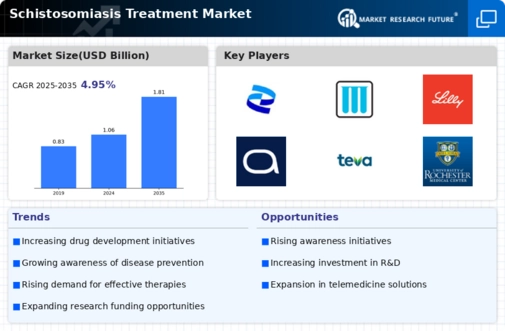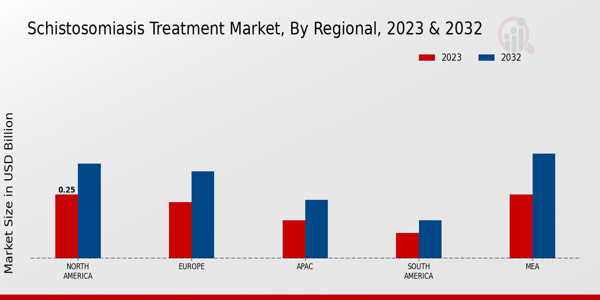Market Growth Projections
Advancements in Treatment Options
Innovations in treatment methodologies are reshaping the Global Schistosomiasis Treatment Market Industry. Recent developments in drug formulations and delivery systems have improved the efficacy and safety profiles of existing treatments. For example, the introduction of new praziquantel formulations aims to enhance patient compliance and reduce side effects. These advancements may lead to increased adoption rates among healthcare providers, thereby driving market growth. The expected compound annual growth rate (CAGR) of 4.96% from 2025 to 2035 indicates a robust market response to these innovations, as they align with the growing demand for effective schistosomiasis treatments.
Increased Awareness and Education
Heightened awareness and educational campaigns about schistosomiasis are pivotal in shaping the Global Schistosomiasis Treatment Market Industry. Public health organizations are actively working to inform communities about the disease's transmission and prevention methods. This increased awareness is likely to lead to earlier diagnosis and treatment, thereby reducing the disease burden. As more individuals seek treatment, the market is expected to expand significantly. The projected market value of 1.06 USD Billion in 2024 may serve as a baseline for future growth driven by these educational initiatives.
Government Initiatives and Funding
Government initiatives aimed at controlling schistosomiasis significantly influence the Global Schistosomiasis Treatment Market Industry. Various countries have launched programs to combat the disease, often supported by international funding. For instance, the World Bank and other organizations have allocated substantial resources for treatment and prevention strategies. Such funding not only enhances access to medications but also promotes research and development of new therapies. The anticipated growth of the market to 1.81 USD Billion by 2035 reflects the potential impact of these initiatives on treatment accessibility and overall disease management.
Rising Prevalence of Schistosomiasis
The increasing incidence of schistosomiasis globally is a primary driver for the Global Schistosomiasis Treatment Market Industry. According to the World Health Organization, over 240 million people are currently infected with schistosomiasis, particularly in sub-Saharan Africa. This alarming statistic highlights the urgent need for effective treatment options. As awareness of the disease grows, governments and health organizations are likely to invest more in treatment solutions, thereby expanding the market. The projected market value of 1.06 USD Billion in 2024 underscores the financial implications of addressing this public health challenge.
Global Collaborations and Partnerships
Collaborative efforts among global health organizations, governments, and pharmaceutical companies are instrumental in advancing the Global Schistosomiasis Treatment Market Industry. Partnerships facilitate resource sharing, research funding, and the development of comprehensive treatment strategies. For instance, initiatives like the Schistosomiasis Control Initiative have united various stakeholders to combat the disease effectively. Such collaborations enhance the distribution of treatment options and improve access in endemic regions. The anticipated growth trajectory of the market, reaching 1.81 USD Billion by 2035, may be significantly influenced by these synergistic efforts.














